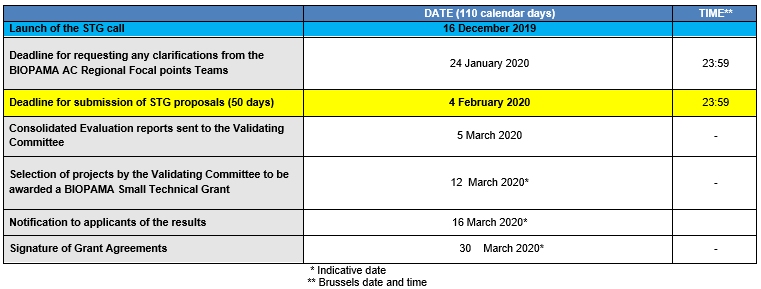For better user experience, please use another browser.
The first call for proposals for small technical grants was open from 16 December 2019 to 4 February 2020. New calls will be open in the future.
The purpose of BIOPAMA Small Technical Grants (STGs) is to address pressing and straightforward needs that are already clearly identified.
The STG proposal and its activities must be justified by a diagnostic tool, a quantified management and governance assessment tools (including IMET, PAME tools – e.g. METT, RAPPAM, Green List, EoH, or equivalent) or if not available, strategic documents at the protected area, national and regional levels, or if not available validated studies by the PAs management authorities. If no clear reference is given of the diagnostic tools for justifying the application, the proposal will be rejected.
There is however an exception to this criterion when the objective of the STG is to implement a quantitative management/ governance assessment. In this case, there is no need for a prior justification with a diagnostic tool, as the objective is actually to identify priorities for action.
Small Technical Grants will fund exclusively supplies and equipment, works or services for a value of:
Unlike the Medium Grants, there is no co-funding required for Small Technical Grants.
Examples of activities that could be supported by a BIOPAMA Action Component STG:
o National/Sub-national agencies in charge of protected and conserved areas; or
o Protected and conserved Areas (including ICCAs[3]) represented by its legal representative.
and
and
The maximum duration is 12 months but it can be shorter depending on the type of activities funded.
The grant application process for BIOPAMA STG comprises a single stage, with the submission of a full proposal.
All Small Technical Grant Proposals should be submitted electronically on the BIOPAMA Action Component Portal. Submissions on paper or by e-mail will not be accepted.
Only applications sent by the deadline stated in the description of the call will be accepted.
Small Technical Grants Guidelines
Frequently Asked Questions about STGs (updated)
Procurement policy for BIOPAMA grants recipients
Webinar: Small Technical Grants Eastern and Southern Africa focus)
Webinar: Small Technical Grants (Pacific focus)
Useful forms in Word and Excel format are available in your applicant space in the portal. You can access the forms once you click on the “Log In/ Sign Up” button.

Footnotes
[1] Lethal equipment is not eligible for EDF funds.
[2] In this particular case, no prior identification by a diagnostic tool is needed.
[3] Some protected areas might be managed by local organisations, indigenous people and local communities (ICCAs), or private organisations.
[4] The ACP countries eligible to the BIOPAMA Action Component encompass 78 countries (in alphabetical order): Angola – Antigua and Barbuda – Belize – Cape Verde – Comoros – Bahamas – Barbados – Benin – Botswana – Burkina Faso – Burundi – Cameroon – Central African Republic – Chad – Congo (Brazzaville) – Congo (Kinshasa) – Cook Islands – Côte d’Ivoire – Djibouti – Dominica – Dominican Republic – Eritrea – Ethiopia – Fiji – Gabon – Gambia – Ghana – Grenada – Republic of Guinea – Guinea-Bissau – Equatorial Guinea – Guyana – Haiti – Jamaica – Kenya – Kiribati – Lesotho – Liberia – Madagascar – Malawi – Mali – Marshall Islands – Mauritania – Mauritius – Micronesia – Mozambique – Namibia – Nauru – Niger – Nigeria – Niue – Palau – Papua New Guinea – Rwanda – St. Kitts and Nevis – St. Lucia – St. Vincent and the Grenadines – Solomon Islands – Samoa – Sao Tome and Principe – Senegal – Seychelles – Sierra Leone – Somalia – South Africa* – Sudan – South Sudan* – Suriname – Swaziland – Tanzania – Timor Leste – Togo – Tonga – Trinidad and Tobago – Tuvalu – Uganda – Vanuatu – Zambia – Zimbabwe.
* The EUTF represents the main catalyst of EU development funds for South Sudan. Only project proposals including transboundary activities are eligible for supporting stakeholders in South Sudan.
*While natural and legal persons established in South Africa are eligible to participate in procedures financed by the 10th/11th EDF, South Africa cannot be a beneficiary of contracts financed by the 10th/11th EDF.